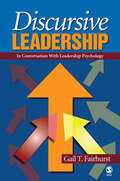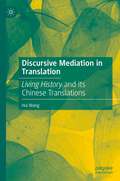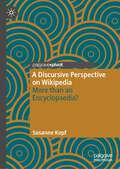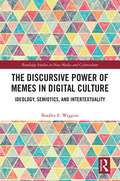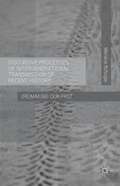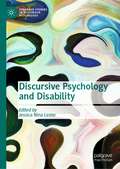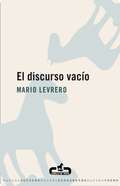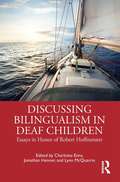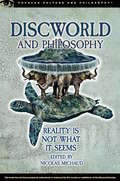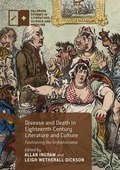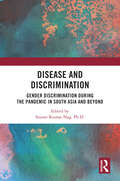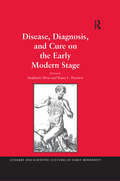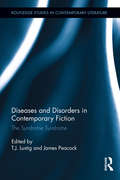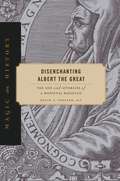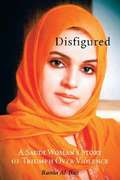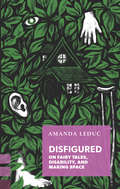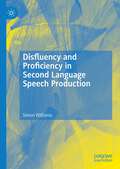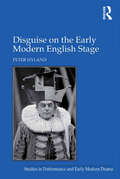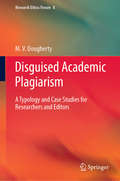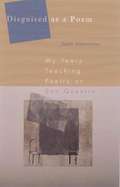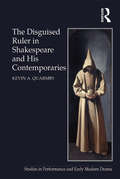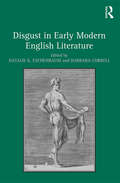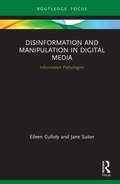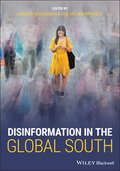- Table View
- List View
Discursive Leadership: In Conversation with Leadership Psychology
by Gail T Fairhurst2007 National Communication Association, Organizational Communication Division, "Best Book" AwardCiting the well known adage that there are as many definitions of leadership as there are leadership scholars, Fairhurst acknowledges the contributions which psychologists have made to leadership research, before probing the inevitable limitations to their formidable body of work. Fairhurst′s work is also thought provoking on the issue of authenticity on the part of leaders."—HUMAN RELATIONSDiscursive Leadership: In Conversation with Leadership Psychology presents a new, groundbreaking way for scholars and graduate students to examine and explore leadership. Differing from a psychological approach to leadership which tries to get inside the heads of leaders and employees, author Gail Fairhurst focuses on the social or communicative aspects between them. A discursive approach to leadership introduces a host of relatively new ideas and concepts and helps us understand leadership′s changing role in organizations. Key Features: Compares and contrasts discursive leadership with leadership psychology: This comparison facilitates a clearer definition of discursive leadership. Presents new ways to study leadership: By treating each discourse concept as a heuristic device and supporting each concept with examples, new ways to study leadership are introduced by focusing on key concepts from the organizational discourse literature. Addresses some key challenges within leadership psychology: Each chapter begins with an ongoing debate in leadership psychology and illustrates how a discursive approach can join that debate. Charimatic leadership, leader-member exchange, authentic leadership are just a few of the examples.Offers reactions from leadership psychologists: Leadership psychologists and other discourse scholars respond to the author′s proposed ′conversation′ between them broadening the debate and introducing new perspectives. Provides quick reviews and extended examples: The book includes critical summaries at the end of each chapter and easy-to-reference appendices. Intended Audience: This book helps scholars, researchers, and practitioners understand the complexities of leadership as it continues to evolve due to such influences as globalization, technology change, and democratization of the workplace. It is also an excellent text for graduate courses such as Leadership; Rhetoric of Leadership; Interpretive Studies of Organizational Communication; Organizational Communication; and Leadership & Communication in the departments of communication, business & management, psychology, and educational administration.
Discursive Mediation in Translation: Living History and its Chinese Translations
by Hui WangThis book explores the actual process of mediation operation in the translation process and the interaction between mediation and social structure. It defines mediation in translation in a parameterized manner, characterizing the linguistic properties of mediation for ease of mediation identification. On this basis, it puts forward an integrated systematic approach to map out mediation operation at the text level and discuss the interactive relationship between mediation and social structure, with a view to unveiling how the source text is altered for the purpose of power balance in the translation process. It is a key read for those interested in better understanding of how translators mediate in the translation process so as to maneuver a text to achieve a certain purpose, thereby increasing mediation efficiency and avoiding potential pitfalls in mediation operation. It will be of interest to students and scholars in translation studies, professional translators, as well as those working in language and culture, intercultural communication, and cultural studies.
A Discursive Perspective on Wikipedia: More than an Encyclopaedia?
by Susanne KopfThis book provides a concise yet comprehensive guide to Wikipedia for researchers and students of linguistics, discourse and communication studies, redressing the gap in research on Wikipedia in these fields and encouraging scholars to explore Wikipedia further as a platform and a medium. Drawing on Herring's situational and medium factors, as well as related developments in (critical) discourse studies, the author studies the online encyclopaedia both theoretically and empirically, examining its origins, production and consumption before turning to a discussion of its societal significance and function(s). This book will be of interest to Wikipedia scholars from a range of disciplines, as well as those with a broader interest in linguistics, discourse studies and the digital humanities.
The Discursive Power of Memes in Digital Culture: Ideology, Semiotics, and Intertextuality (Routledge Studies in New Media and Cyberculture)
by Bradley E. WigginsShared, posted, tweeted, commented upon, and discussed online as well as off-line, internet memes represent a new genre of online communication, and an understanding of their production, dissemination, and implications in the real world enables an improved ability to navigate digital culture. This book explores cases of cultural, economic, and political critique levied by the purposeful production and consumption of internet memes. Often images, animated GIFs, or videos are remixed in such a way to incorporate intertextual references, quite frequently to popular culture, alongside a joke or critique of some aspect of the human experience. Ideology, semiotics, and intertextuality coalesce in the book’s argument that internet memes represent a new form of meaning-making, and the rapidity by which they are produced and spread underscores their importance.
Discursive Processes of Intergenerational Transmission of Recent History: (re)making Our Past
by Mariana AchugarDebates about how to remember politically contested or painful pasts exist throughout the world. As with the case of the Holocaust in Europe and Apartheid in South Africa, South American countries are struggling with the legacy of state terrorism left by the 1970s dictatorships. Coming to terms with the past entails understanding the role different social actors played in those events as well as what those event mean for us today. Young people in these situations have to learn about painful historical events over which there is no national consensus. This book explores discursive processes of intergenerational transmission of recent history through the case of the Uruguayan dictatorship. The main themes of the book are the discursive construction of social memory and intergenerational transmission of contested pasts through recontextualization, resemiotization and intertextuality.
Discursive Psychology and Disability (Palgrave Studies in Discursive Psychology)
by Jessica Nina LesterThis book explores how discursive psychology (DP) research can be applied to disability and the everyday and institutional constructions of bodymind differences. Bringing together both theoretical and empirical work, it illustrates how DP might be leveraged to make visible nuanced understandings of disability and difference writ large. The authors argue that DP can attend to how such realities are made relevant, dealt with, and negotiated within social practices in the study of disability. They contend that DP can be used to unearth the nuanced and frequently taken for granted ways in which disability is made real in both everyday and institutional talk, and can highlight the very ways in which differences are embodied in social practices – specifically at the level of talk and text. This book demonstrates that rather than simply staying at the level of theory, DP scholars can make visible the actual means by which disabilities and differences more broadly are made real, resisted, contested, and negotiated in everyday social actions. This book aims to expand conceptions of disability and to deepen the – at present, primarily theoretical – critiques of medicalization.
El discurso vacío
by Mario LevreroEn clave kafkiana, o, si se prefiere, al modo de Juan Carlos Onetti, esta extraordinaria novela está protagonizada por un escritor que se dedica a observar su propia caligrafía en busca de respuestas sobre su identidad. Esos trazos sinuosos le brindan respuestas sobre el significado de escribir, sobre las angustias de la escritura creativa, y en especial, sobre la siempre mágica relación de la escritura con la vida.
Discussing Bilingualism in Deaf Children: Essays in Honor of Robert Hoffmeister
by Charlotte EnnsThis collection unites expert scholars in a comprehensive survey of critical topics in bilingual deaf education. Drawing on the work of Dr. Robert Hoffmeister, chapters explore the concept that a strong first language is critical to later learning and literacy development. In thought-provoking essays, authors discuss the theoretical underpinnings of bilingual deaf education, teaching strategies for deaf students, and the unique challenges of signed language assessment. Essential for anyone looking to expand their understanding of bilingualism and deafness, this volume reflects Dr. Hoffmeister’s impact on the field while demonstrating the ultimate resilience of human language and literacy systems.
Discworld and Philosophy
by Nicolas MichaudIn Discworld, unlike our own frustrating Roundworld, everything makes sense. The world is held up by elephants standing on the back of a swimming turtle who knows where he's going, the sun goes round the world every day, so it doesn't have to be very hot, and things always happen because someone intends them to happen. Millions of fans are addicted to Pratchett's Discworld, and the interest has only intensified since Pratchett's recent death and the release of his final Discworld novel, The Shepherd's Crown, in September 2015. The philosophical riches of Discworld are inexhaustible, yet the brave explorers of Discworld and Philosophy cover a lot of ground. From discussion of Moist von Lipwig's con artistry showing the essential con of the financial system, to the examination of everyone's favorite Discworld character, the murderous luggage, to the lawless Mac Nac Feegles and what they tell us about civil government, to the character Death as he appears in several Discworld novels, Discworld and Philosophy gives us an in-depth treatment of Pratchett's magical universe. Other chapters look at the power of Discworld's witches, the moral viewpoint of the golems, how William de Worde's newspaper illuminates the issue of censorship, how fate and luck interact to shape our lives, and why the more simple and straightforward Discworld characters are so much better at seeing the truth than those with enormous intellects but little common sense.
Disease and Death in Eighteenth-Century Literature and Culture
by Allan Ingram Leigh Wetherall DicksonThis collection examines different aspects of attitudes towards disease and death in writing of the long eighteenth century. Taking three conditions as examples - ennui, sexual diseases and infectious diseases - as well as death itself, contributors explore the ways in which writing of the period placed them within a borderland between fashionability and unfashionability, relating them to current social fashions and trends. These essays also look at ways in which diseases were fashioned into bearing cultural, moral, religious and even political meaning. Works of literature are used as evidence, but also medical writings, personal correspondence and diaries. Diseases or conditions subject to scrutiny include syphilis, male impotence, plague, smallpox and consumption. Death, finally, is looked at both in terms of writers constructing meanings within death and of the fashioning of posthumous reputation.
Disease and Death in Eighteenth-Century Literature and Culture: Fashioning the Unfashionable (Palgrave Studies in Literature, Science and Medicine)
by Allan Ingram Leigh Wetherall DicksonThis collection examines different aspects of attitudes towards disease and death in writing of the long eighteenth century. Taking three conditions as examples – ennui, sexual diseases and infectious diseases – as well as death itself, contributors explore the ways in which writing of the period placed them within a borderland between fashionability and unfashionability, relating them to current social fashions and trends. These essays also look at ways in which diseases were fashioned into bearing cultural, moral, religious and even political meaning. Works of literature are used as evidence, but also medical writings, personal correspondence and diaries. Diseases or conditions subject to scrutiny include syphilis, male impotence, plague, smallpox and consumption. Death, finally, is looked at both in terms of writers constructing meanings within death and of the fashioning of posthumous reputation.
Disease and Discrimination: Gender Discrimination during the Pandemic in South Asia and Beyond
by Sourav Kumar NagThis book examines disease in the context of gender discrimination. It highlights and explores how socio-economic, political, cultural, and gender dimensions play a crucial role in understanding and defining disease.Through two broad categories – non-literary and literary – the volume discusses concerns such as media representation of gender, racial violence, domestic violence, and healthcare discrimination during Covid-19 pandemic, and focuses on the literary representation of gender discrimination related to diseases within and beyond South Asia. The chapters are based on fieldwork, demographic investigations, and statistics that offer a clear and comprehensive insight into the problems.This book will be beneficial to students and researchers of gender studies, pandemic studies, literature, anthropology, social sciences, and disease humanities.
Disease, Diagnosis, and Cure on the Early Modern Stage (Literary and Scientific Cultures of Early Modernity)
by Stephanie MossThis collection of essays makes an important contribution to scholarship by examining how the myths and practices of medical knowledge were interwoven into popular entertainment on the early modern stage. Rather than treating medicine, the theater, and literary texts separately, the contributors show how the anxieties engendered by medical socio-scientific investigations were translated from the realm of medicine to the stage by Renaissance playwrights, especially Shakespeare. As a whole, the volume reconsiders typical ways of viewing medical theory and practice while individual essays focus on gender and ethnicity, theatrical impersonation, medical counterfeit and malfeasance, and medicine as it appears in the form of various political metaphors.
Diseases and Disorders in Contemporary Fiction: The Syndrome Syndrome (Routledge Studies in Contemporary Literature #10)
by James Peacock T. J. LustigThe essays in this collection address the current preoccupation with neurological conditions and disorders in contemporary literature by British and American writers. The book places these fictional treatments within a broader cultural and historical context, exploring such topics as the two cultures debate, the neurological turn, postmodernism and the post-postmodern, and responses to September 11th. Considering a variety of materials including mainstream literary fiction, the graphic novel, popular fiction, autobiographical writing, film, and television, contributors consider the contemporary dimensions of the interface between the sciences and humanities, developing the debate about the post-postmodern as a new humanism or a return to realism and investigating questions of form and genre, and of literary continuities and discontinuities. Further, the essays discuss contemporary writers’ attempts to engage the relation between the individual and the social, looking at the relation between the "syndrome syndrome" (referring to the prevalence in contemporary literature of neurological phenomena evident at the biological level) and existing work in the field of trauma studies (where explanations tend to have taken a psychoanalytical form), allowing for perspectives that question some of the assumptions that have marked both these fields. The current literary preoccupation with neurological conditions presents us with a new and distinctive form of trauma literature, one concerned less with psychoanalysis than with the physical and evolutionary status of human beings.
Disenchanting Albert the Great: The Life and Afterlife of a Medieval Magician (Magic in History)
by David J. Collins, S. J.Albert the Great (1200–1280) was a prominent Dominican friar, a leading philosopher, and the teacher of Thomas Aquinas. He also endorsed the use of magic. Controversial though that stance would have been, Albert was never punished or repudiated for what he wrote. Albert’s reception followed instead a markedly different course, leading ultimately to his canonization by the Catholic Church in 1931. But his thoughts about magic have been debated for centuries. Disenchanting Albert the Great takes Albert’s contested reputation as a case study for the long and complex history surrounding the concept of magic and magic’s relationship to science and religion. Over the centuries, Albert was celebrated for his magic, or it was explained away—but he was never condemned. In the fifteenth century, members of learned circles first attempted to distance Albert from magic, with the goal of exonerating him of superstition, irrationality, and immorality. Disenchanting Albert the Great discusses the philosopher’s own understanding of magic; an early, adulatory phase of his reputation as a magician; and the three primary strategies used to exonerate Albert over the centuries. In the end, Disenchanting Albert the Great tells the story of a thirteenth-century scholar who worked to disenchant the natural world with his ideas about magic but who himself would not be disenchanted until the modern era. This accessible and insightful history will appeal to those interested in Albert the Great, Catholic Church history, the history of magic, and Western understandings of the natural and the rational over time.
Disfigured: A Saudi Woman's Story of Triumph over Violence
by Rania Al-Baz Catherine SpencerEvery morning for the past six years, Rania al-Baz has been the smiling face of a family program on Saudi television. She was a young, beautiful Saudi TV new anchor-the first woman to have such a job-when her abusive husband beat her into a coma and left her for dead. She remained in a coma for four days and later underwent thirteen operations to reconstruct her face. When she agreed to let horriying pictures of her ravaged face be made public, her story sparked general criticism of Saudi culture. A month after the tragedy, the first Saudi research into domestic violence began at King Saud University in Riyadh. Rania's story subsequently appeared in the press all over the world.
Disfigured: On Fairy Tales, Disability, and Making Space (Exploded Views)
by Amanda LeducFairy tales shape how we see the world, so what happens when you identify more with the Beast than Beauty? If every disabled character is mocked and mistreated, how does the Beast ever imagine a happily-ever-after? Amanda Leduc looks at fairy tales from the Brothers Grimm to Disney, showing us how they influence our expectations and behaviour and linking the quest for disability rights to new kinds of stories that celebrate difference. "Leduc persuasively illustrates the power of stories to affect reality in this painstakingly researched and provocative study that invites us to consider our favorite folktales from another angle." —Sara Shreve, Library Journal
Disfluency and Proficiency in Second Language Speech Production
by Simon WilliamsThis book explores the concept of disfluency in speech production, particularly as it occurs in the context of second language acquisition. Drawing on examples from learner speech at three levels (beginner, intermediate and advanced), the author argues that acquiring target language norms for performing disfluency is essential to an individual being recognized as fluent in a language by fellow-speakers. Starting with a survey of the psycholinguistic research in this area, he then applies a sociolinguistic lens to examine how a learner's social and educational background impacts the types of disfluencies in their speech. This book will be of interest to readers in fields such as (applied) linguistics and second language acquisition, psychology and education.
Disguise on the Early Modern English Stage (Studies in Performance and Early Modern Drama)
by Peter HylandDisguise devices figure in many early modern English plays, and an examination of them clearly affords an important reflection on the growth of early theatre as well as on important aspects of the developing nation. In this study Peter Hyland considers a range of practical issues related to the performance of disguise. He goes on to examine various conceptual issues that provide a background to theatrical disguise (the relation of self and "other", the meaning of mask and performance). He looks at many disguise plays under three broad headings. He considers moral issues (the almost universal association of disguise with "evil"); social issues (sumptuary legislation, clothing, and the theatre, and constructions of class, gender and national or racial identity); and aesthetic issues (disguise as an emblem of theatre, and the significance of disguise for the dramatic artist). The study serves to examine the significant ways in which disguise devices have been used in early modern drama in England.
Disguised Academic Plagiarism: A Typology and Case Studies for Researchers and Editors (Research Ethics Forum #8)
by M. V. DoughertyThis volume is the first book-length study of disguised forms of plagiarism that mar the body of published research in humanities disciplines. As a contribution to applied research ethics, this practical guide offers a typology of the principal forms of disguised plagiarism. It provides detailed analyses, in-depth case studies, and useful flow charts to assist researchers, editors, and publishers in protecting the integrity of the body of published research literature. Disguised plagiarism is more subtle than copy-and-paste plagiarism; all its varieties involve some additional concealment that creates further distance between the plagiarizing text and its source. These disguised forms are the most difficult forms of plagiarism to detect. Readers of the volume will become acquainted with the subtler forms of plagiarism that corrupt the production and dissemination of knowledge in humanities fields. The book is valuable not only to those interested in research ethics, but also to those in humanities fields including philosophy, theology, and history.
Disguised as a Poem: My Years Teaching Poetry at San Quentin
by Judith TannenbaumMemoir of teaching poetry at a California prison. Includes some of the prisoners' poems.
The Disguised Ruler in Shakespeare and his Contemporaries (Studies in Performance and Early Modern Drama)
by Kevin A. QuarmbyIn the early seventeenth century, the London stage often portrayed a ruler covertly spying on his subjects. Traditionally deemed 'Jacobean disguised ruler plays', these works include Shakespeare's Measure for Measure, Marston's The Malcontent and The Fawn, Middleton's The Phoenix, and Sharpham's The Fleer. Commonly dated to the arrival of James I, these plays are typically viewed as synchronic commentaries on the Jacobean regime. Kevin A. Quarmby demonstrates that the disguised ruler motif actually evolved in the 1580s. It emerged from medieval folklore and balladry, Tudor Chronicle history and European tragicomedy. Familiar on the Elizabethan stage, these incognito rulers initially offered light-hearted, romantic entertainment, only to suffer a sinister transformation as England awaited its ageing queen's demise. The disguised royal had become a dangerously voyeuristic political entity by the time James assumed the throne. Traditional critical perspectives also disregard contemporary theatrical competition. Market demands shaped the repertories. Rivalry among playing companies guaranteed the motif's ongoing vitality. The disguised ruler's presence in a play reassured audiences; it also facilitated a subversive exploration of contemporary social and political issues. Gradually, the disguised ruler's dramatic currency faded, but the figure remained vibrant as an object of parody until the playhouses closed in the 1640s.
Disgust in Early Modern English Literature
by Natalie K. Eschenbaum Barbara CorrellWhat is the role of disgust or revulsion in early modern English literature? How did early modern English subjects experience revulsion and how did writers represent it in poetry, plays, and prose? What does it mean when literature instructs, delights, and disgusts? This collection of essays looks at the treatment of disgust in texts by Spenser, Shakespeare, Donne, Jonson, Herrick, and others to demonstrate how disgust, perhaps more than other affects, gives us a more complex understanding of early modern culture. Dealing with descriptions of coagulated eye drainage, stinky leeks, and blood-filled fleas, among other sensational things, the essays focus on three kinds of disgusting encounters: sexual, cultural, and textual. Early modern English writers used disgust to explore sexual mores, describe encounters with foreign cultures, and manipulate their readers' responses. The essays in this collection show how writers deployed disgust to draw, and sometimes to upset, the boundaries that had previously defined acceptable and unacceptable behaviors, people, and literatures. Together they present the compelling argument that a critical understanding of early modern cultural perspectives requires careful attention to disgust.
Disinformation and Manipulation in Digital Media: Information Pathologies (Routledge Focus on Communication and Society)
by Eileen Culloty Jane SuiterDrawing on research from multiple disciplines and international case studies, this book provides a comprehensive and up-to-date understanding of online disinformation and its potential countermeasures. Disinformation and Manipulation in Digital Media presents a model of the disinformation process which incorporates four cross-cutting dimensions or themes: bad actors, platforms, audiences, and countermeasures. The dynamics of each dimension are analysed alongside a diverse range of international case studies drawn from different information domains including politics, health, and society. In elucidating the interrelationship between the four dimensions of online disinformation and their manifestation in different international contexts, the book demonstrates that online disinformation is a complex problem with multiple, overlapping causes and no easy solutions. The book’s conclusion contextualises the problem of disinformation within broader social and political trends and discusses the relevance of radical innovations in democratic participation to counteract the post-truth environment. This up-to-date and thorough analysis of the disinformation landscape will be of interest to students and scholars in the fields of journalism, communications, politics, and policy as well as policymakers, technologists, and media practitioners.
Disinformation in the Global South
by Herman Wasserman Dani Madrid-MoralesA timely and incisive exploration of disinformation and its impact in the Global South In Disinformation in the Global South, media and communications scholars Herman Wasserman and Dani Madrid-Morales deliver a unique and geographically diverse collection of perspectives on the phenomenon of disinformation as it manifests in the Global South. In many parts of the Global South, coordinated political disinformation campaigns, rumor, and propaganda have long been a part of the social fabric, even before disinformation has become an area of scholarship in the Global North. The way disinformation manifests in this region, and responses to it, can therefore be highly instructive for readers around the world. Through case studies and comparative analyses, the book explores the impact of disinformation in Africa, Latin America, the Arab World and Asia. The chapters in this book discuss the similarities and differences of disinformation in different regions and provide a broad thematic overview of the phenomenon as it manifests across the Global South. After analyzing core concepts, theories and histories from Southern perspectives, contributors explore the experiences of media users and the responses to disinformation by various social actors drawing on examples from a dozen countries. Disinformation in the Global South also includes: A thorough introduction to Southern perspectives on national histories, theories of disinformation, and research methods in disinformation studies Global case studies of cultures of disinformation, including ethnographic insights into how audiences engage with disinformation Comprehensive explorations of responses to online and offline disinformation, including discussions of news literacy and the management of disinformation A valuable resource for scholars of disinformation everywhere, as well as senior undergraduate and graduate students in courses covering transnational or global perspectives to communication studies, Disinformation in the Global South is also an ideal reference for anyone studying or working in media or journalism.
